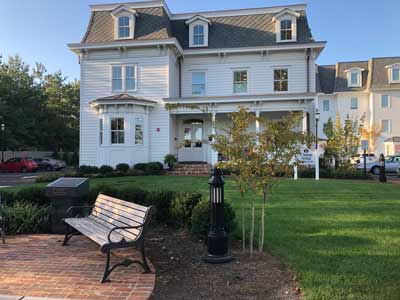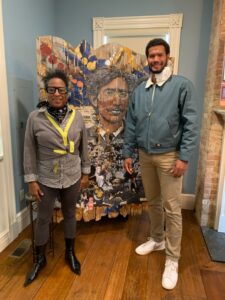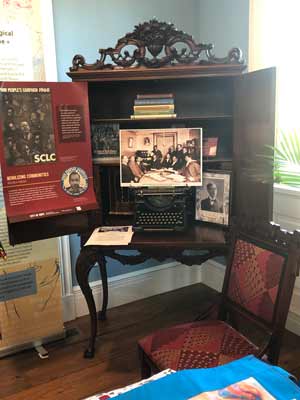At Home
Our Time At Home: On Location
Victorian Gilded Age Has Continuous Connections
From Brooklyn to Red Bank, NJ; Manhattan,Troy, NY and Back

While the City of Troy is featured prominently throughout ‘The Gilded Age,” HBO’s new ten-episode 1880s historical drama series, other areas in the northeast have roles behind the scenes although they are not actually seen in show. They include Brooklyn, New York; Red Bank, New Jersey, and Manhattan, through the re-enactment of an icon in African American media history — T. Thomas Fortune (1856-1928), publisher, editor, journalist, and businessman.
Sullivan Jones of “Harlem” fame, the actor who portrays Mr. Fortune in three episodes of the series, is a resident of Brooklyn, where the Black journalism legend lived before moving to Red Bank in 1901. Fortune’s historic newspaper, The New York Age, was printed in Manhattan. In this first part of our two-part series written by Fern E. Gillespie, Our Time Press journeys through time starting at the site of the actual Fortune family Victorian mansion, now one of New Jersey’s cultural centerpieces. It’s where Mr. Jones traveled for inspiration and research on this iconic figure. (Part 1 of 2)
- by Fern E. Gillespie
Gilda Rogers, a co-founder, and executive director of the T. Thomas Fortune Cultural Center in Red Bank was at the forefront of lobbying government and businesses for years to save the home of legendary 19th and 20th century journalist and civil rights activist T. Thomas Fortune (1856-1928). From the 1880s to the 1920s, he was editor-in chief of America’s largest Black newspapers, The New York Globe, The New York Age and Marcus Garvey’s Negro World. He was a colleague of W.E.B. DuBois, Ida B. Wells and Booker T. Washington.

of the Center where he found “inspiration” for his portrayal.
In 1901, Fortune moved his family from Brooklyn to a stately Victorian mansion in Red Bank, NJ’s prominent Jersey Shore Black community. He named the home Maple Hall and lived there until 1911. Although it was designated a National Landmark in 1976, preservationists pursued saving the decomposing building that the new owners wanted to sell.
In 2013, Gilda was a leading advocate in securing an agreement with developer Roger Mumford, who restored the Victorian and built a Victorian apartment complex surrounding the building. When the T. Thomas Fortune Cultural Center opened in 2018, it became a leading institution on Jersey Shore promoting and preserving Black culture. Our Time Press talked with Gilda about the Afrofuturism-Victorian design of the center.
OTP – You headed the design vision of the T. Thomas Fortune Cultural Center. You are known as a journalist (a reporter for the Asbury Park Press and managing editor of City News, which was New Jersey’s largest Black weekly), and community affairs director of Two River Theatre in Red Bank. What is your design background?
ROGERS – Prior to becoming a journalist, I studied Fashion & Visual Merchandising and Interior Design and graduated from Roberts Walsh Business School, a long time ago, it no longer exists. I also took a few classes at FIT. I then worked for 15 years as a window dresser for major department stores and specialty stores. A lot of the display work I was doing was also connected to interior design, particularly in department stores that had simulated bedrooms, living room settings during that time.
OTP– What was your interior design vision of The Fortune House? How did you coordinate and layout the antique furnishings?
ROGERS – One of our Board members, Robin Blair donated some of the chairs that dictate a particular time period, and we thought it would be a novel concept to have them reupholstered in African designed fabric to bring the two cultures together. We actually had reached out to a reputable interior decorator to work with us. However, her vision was much different from ours. She didn’t see what we did. We wanted the home to reflect Black culture from the time you walked in the door. We parted ways with her quickly. I relied on my own interior design experience, and we went from there. A few of us traveled to Montclair, where we purchased a slew of African inspired fabrics and motifs. Of course, several people wanted to donate items to us. They seemed to think if it were something old then we should have it. However, we were very selective about what pieces of furnishings we chose to accept for the decor of the home. The T. Thomas Fortune Room has a big poster-sized sign that welcomes you to “ A Cultural Textile Experience,” Fortune’s room reflects and showcases an Afro-futurist design that is appealing and appreciated by all who visit the home. My co-decorators were Birgit Mondesir, Robin Blair and Kathy MacAuley, all of whom are Board Members.
OTP – Why was it unique that the Fortune House organizers collaborated with developer Roger Mumford, who restored the house and created Victorian apartment complex?
ROGERS – Roger Mumford was the building developer and financier of the T. Thomas Fortune Cultural Center. He deeded the home back to the T. Thomas Fortune Foundation for $1 to run as a Cultural Center, to bring people together to eradicate the injustices that prevail in our society. If we can start to understand one another and form relationships that engage and promote different perspectives, as opposed to one point of view, perhaps we can start to build trust and understanding between the races. It’s a challenge, however, I am grateful to Roger Mumford for being someone who cares about humankind and what that should represent.
OTP – What are the special spaces in the T. Thomas Fortune Cultural Center?
ROGERS – Adjacent to the Fortune Room is the Ida B. Wells Gallery, which houses our current exhibit, “A Love Letter to Count Basie: From The Great Migration to The Harlem Renaissance.” I am currently working on an exhibit upstairs which is in honor of the Parker Family. Ancestral Ascension is the title of this exhibit, which honors a family of Black medical doctors, educators, and leaders in the community. It is due to open late March. And there’s the Carrie Smiley Fortune Research Library that is dedicated to Carrie Fortune, the wife of T. Thomas Fortune and one of the founding members of the National Urban League.
The T. Thomas Fortune Cultural Center is open to the public on Saturdays and Sundays from 1:00pm – 5:00pm. For more information on events and programs: www.tthomasfortuneculturalcenter.org
Fortune House and Memories Preserved

Preservationists, among them Gilda Rogers led a successful effort to save The T. Thomas Fortune House in Red Bank, N.J. from destruction. In 1901, Fortune and his family moved from Brooklyn to Red Bank. Antique furniture, not the originals, were refurbished in contemporary African fabrics by Gilda and other designers, in honor of the publisher’s civil rights activism. Born a slave and freed after the Civil War, Fortune rose to become journalist, editor and publisher of the first nationally syndicated African American owned newspaper. Fortune also founded the organization which later became the NAACP. He was a colleague of the most influential leaders of the day, among them Booker T. Washington, WEB DuBois, Ida B. Wells, and Marcus Garvey. Fortune wrote for The Amsterdam News. He also served as an editor of Marcus Garvey’s Negro World. (Photo Credit: Fern E. Gillespie)

